Rural Roads Are Paving the Way for Land-Use Intensification in the Uplands of Laos
Abstract
:1. Introduction
2. Materials and Methods
2.1. Study Site
2.2. Methodological Framework
2.3. Data Collection and Analysis
3. Results
3.1. Road Construction and Land-Use Intensification
3.1.1. Influence of Government Policies on Land-Use Dynamics
3.1.2. The Rural Road Brought the Maize Market
3.1.3. The Maize Boom through the Lens of Feeder Road Expansion
3.2. Road Construction Cycles and Land Degradation
3.2.1. The Governance of Roads and Crops Expansion
3.2.2. Impacts of the Maize Boom on Landscapes and Livelihoods
3.2.3. Lessons Learnt from the Maize Boom
4. Discussion
4.1. Land-Use Intensification as a Gateway to Agrarian Capitalism
4.2. Land-Use Plans and Road Construction Cycles
5. Conclusions
Author Contributions
Funding
Acknowledgments
Conflicts of Interest
Appendix A. Analysis of Remote Sensing Data
| Year | Satellite/Sensor | Acquisition Date | Sources of Images |
|---|---|---|---|
| 2003 | Landsat 7/ETM+ | 10 April 2003 | glovis.usgs.gov (accessed on 22 March 2021) |
| 2008 | Landsat 7/ETM+ | 2 January 2008 | glovis.usgs.gov (accessed on 22 March 2021) |
| 2013 | Landsat 7/ETM+ | 20 March 2013 | glovis.usgs.gov (accessed on 22 March 2021) |
| 2014 | Aerial Photo | 2014 | National Geographic Department of Laos |
| 2014 | GoogleEarth | 15 May 2014 | GoogleEarth |
| 2015 | Landsat 8/OLI | 18 March 2015 | glovis.usgs.gov (accessed on 22 March 2021) |
| 2015 | SPOT7 | 31 March 2015 | Ministry of Agriculture and Forestry, Laos |
| Code | Categories | Description |
|---|---|---|
| 1 | Dense forest | This refers to forestland of native species, where there are no clearly visible indications of human activities and the ecological processes are not significantly disturbed. |
| 2 | Open forest | This refers to an area of forest regenerated largely through natural processes after significant human or natural disturbance of the original forest vegetation. This category includes the areas of mixed woody with bamboo and old fallow. |
| 3 | Fallow land | This refers to vegetation types where the dominant woody elements are shrubs i.e., woody perennial plants, generally more than 0.5 m and less than 5 m in height at maturity and without a definite crown. |
| 4 | Upland crop | This category refers to land area in higher slope which is mainly used for dry cropping such as upland rice, maize, etc. |
| 5 | Paddy field | This category refers to paddy fields in both dry-season and wet-season valley-bottom fields. |
| 6 | Water body | This category includes land that is covered or saturated by water for all or part of the year and that does not fall into the forestland, cropland, grassland, or settlements categories. It includes reservoirs, natural rivers, and ponds. |
| 7 | Residential area | This category includes all developed land, including transportation infrastructure and human settlements of any visible size. |
| Classified Data | Reference Data | C-Total | Num. Correct | PA (%) | UA (%) | (K^) stat. | ||||||
|---|---|---|---|---|---|---|---|---|---|---|---|---|
| DF | OF | FL | UC | PF | WB | RA | ||||||
| DF * | 30 | 3 | 1 | 0 | 0 | 0 | 0 | 34 | 30 | 96.77 | 88.24 | 0.86 |
| OF | 1 | 93 | 9 | 2 | 0 | 0 | 0 | 105 | 93 | 86.92 | 88.57 | 0.81 |
| FL | 0 | 9 | 62 | 0 | 0 | 0 | 0 | 71 | 62 | 74.70 | 87.32 | 0.81 |
| UC | 0 | 2 | 11 | 34 | 0 | 0 | 0 | 47 | 34 | 94.44 | 72.34 | 0.68 |
| PF | 0 | 0 | 0 | 0 | 15 | 0 | 1 | 16 | 15 | 100 | 93.75 | 0.93 |
| WB | 0 | 0 | 0 | 0 | 0 | 2 | 0 | 2 | 2 | 100 | 100 | 1 |
| RA | 0 | 0 | 0 | 0 | 0 | 0 | 5 | 5 | 5 | 83.33 | 100 | 1 |
| R-Total | 31 | 107 | 83 | 36 | 15 | 2 | 6 | 280 | 241 | 90.88 | 90.03 | 0.81 |
| Overall Classification Accuracy = 86.07% | ||||||||||||
Appendix B. Role-Playing Game about the Construction of Maize Feeder Roads
Appendix B.1. Background
Appendix B.2. Description of the Game

Appendix B.3. Group 1 (Example of Xiengdaene Village)

Appendix B.4. Group 2 (Example of Natong Village)

Appendix B.5. Conclusions

References
- Van Vliet, N.; Mertz, O.; Heinimann, A.; Langanke, T.; Pascual, U.; Schmook, B.; Adams, C.; Schmidt-Vogt, D.; Messerli, P.; Leisz, S.; et al. Trends, drivers and impacts of changes in swidden cultivation in tropical forest-agriculture frontiers: A global assessment. Glob. Environ. Chang. 2012, 22, 418–429. [Google Scholar] [CrossRef]
- Cramb, R.A.; Colfer, C.J.P.; Dressler, W.; Laungaramsri, P.; Le, Q.T.; Mulyoutami, E.; Peluso, N.L.; Wadley, R.L. Swidden Transformations and Rural Livelihoods in Southeast Asia. Hum. Ecol. 2009, 37, 323–346. [Google Scholar] [CrossRef] [Green Version]
- Dressler, W.H.; Wilson, D.; Clendenning, J.; Cramb, R.; Keenan, R.; Mahanty, S.; Bruun, T.B.; Mertz, O.; Lasco, R.D. The impact of swidden decline on livelihoods and ecosystem services in Southeast Asia: A review of the evidence from 1990 to 2015. Ambio 2017, 46, 291–310. [Google Scholar] [CrossRef] [PubMed] [Green Version]
- Castella, J.-C. Agrarian transition and farming system dynamics in the uplands of South-East Asia. In Proceedings of the 3rd International Conference on Conservation Agriculture in Southeast Asia, Hanoi, Vietnam, 10 December 2012; pp. 4–20. [Google Scholar]
- Rigg, J. Roads, marketization and social exclusion in Southeast Asia. What do roads do to people? J. Humanit. Soc. Sci. Southeast Asia 2002, 158, 619–636. [Google Scholar] [CrossRef] [Green Version]
- Rerkasem, K.; Rerkasem, B. Montane Mainland South-East Asia: Agroecosystems in transition. Glob. Environ. Chang. 1995, 5, 313–322. [Google Scholar] [CrossRef]
- Van de Walle, D. Impact evaluation of rural road projects. J. Dev. Eff. 2009, 1, 15–36. [Google Scholar] [CrossRef]
- Demenge, J. Development theory, regional politics and the unfolding of the ‘roadscape’ in Ladakh, North India. J. Infrastruct. Dev. 2015, 7, 1–18. [Google Scholar] [CrossRef]
- Meyfroidt, P. Approaches and terminology for causal analysis in land systems science. J. Land Use Sci. 2016, 4248, 1–27. [Google Scholar] [CrossRef]
- Scott, J.C. Seeing Like a State: How Certain Schemes to Improve the Human Condition Have Failed; Yale University Press: New Haven, London, 1998. [Google Scholar]
- Warr, P. The impact of road development on poverty in the Lao PDR. Asia Pac. Dev. J. 2006, 13, 1–23. [Google Scholar]
- Heinimann, A.; Hett, C.; Hurni, K.; Messerli, P.; Epprecht, M.; Jørgensen, L.; Breu, T. Socio-Economic Perspectives on Shifting Cultivation Landscapes in Northern Laos. Hum. Ecol. 2013, 41, 51–62. [Google Scholar] [CrossRef] [Green Version]
- Epprecht, M.; Minot, N.; Dewina, R.; Messerli, P.; Heinimann, A. The Geography of Poverty and Inequality in the Lao PDR; University of Bern and International Food Policy Research Institute: Bern, Switzerland, 2008; ISBN 978-3-905835-09-0. [Google Scholar]
- Bryceson, D.F.; Bradbury, A.; Bradbury, T. Roads to Poverty Reduction? Exploring Rural Roads’ Impact on Mobility in Africa and Asia. Dev. Policy Rev. 2008, 26, 459–482. [Google Scholar] [CrossRef]
- Hall, D. Where the streets are paved with prawns: Crop booms and migration in Southeast Asia. Crit. Asian Stud. 2011, 43, 507–530. [Google Scholar] [CrossRef]
- Kong, R.; Diepart, J.C.; Castella, J.C.; Lestrelin, G.; Tivet, F.; Belmain, E.; Bégué, A. Understanding the drivers of deforestation and agricultural transformations in the Northwestern uplands of Cambodia. Appl. Geogr. 2019, 102, 84–98. [Google Scholar] [CrossRef] [Green Version]
- Vicol, M.; Pritchard, B.; Htay, Y.Y. Rethinking the role of agriculture as a driver of social and economic transformation in Southeast Asia’s upland regions: The view from Chin State, Myanmar. Land Use Policy 2018, 72, 451–460. [Google Scholar] [CrossRef]
- Li, T.M. Land’s End: Capitalist Relations on an Indigenous Frontier; Duke University Press: Durham, NC, USA, 2014; ISBN 0822357054. [Google Scholar]
- Willi, Y. Of Maize and Men. Contract Farming in the Houaphanh Province of the Lao PDR: Scale, Scope and Impacts on Peasant Livelihoods. Ph.D. Thesis, University of Bern, Bern, Switzerland, 2011. [Google Scholar]
- Junquera, V.; Grêt-Regamey, A. Crop booms at the forest frontier: Triggers, reinforcing dynamics, and the diffusion of knowledge and norms. Glob. Environ. Chang. 2019, 57, 101929. [Google Scholar] [CrossRef]
- Vongvisouk, T.; Broegaard, R.B.; Mertz, O.; Thongmanivong, S. Rush for cash crops and forest protection: Neither land sparing nor land sharing. Land Use Policy 2016, 55, 182–192. [Google Scholar] [CrossRef]
- Borras, S.M.; Franco, J.C.; Isakson, S.R.; Levidow, L.; Vervest, P. The rise of flex crops and commodities: Implications for research. J. Peasant Stud. 2016, 43, 93–115. [Google Scholar] [CrossRef] [Green Version]
- Gerber, J.-F. The role of rural indebtedness in the evolution of capitalism. J. Peasant Stud. 2014, 41, 729–747. [Google Scholar] [CrossRef]
- Mahanty, S.; Milne, S. Anatomy of a boom: Cassava as a “gateway” crop in Cambodia’s north eastern borderland. Asia Pac. Viewp. 2016, 57, 180–193. [Google Scholar] [CrossRef]
- Cramb, R.; Manivong, V.; Newby, J.C.; Sothorn, K.; Sibat, P.S. Alternatives to land grabbing: Exploring conditions for smallholder inclusion in agricultural commodity chains in Southeast Asia. J. Peasant Stud. 2017, 44, 939–967. [Google Scholar] [CrossRef]
- Taylor, P. Frontier commoditisation in post-socialist Southeast Asia. Asia Pac. Viewp. 2016, 57, 145–153. [Google Scholar] [CrossRef]
- Rigg, J. Living with Transition in Laos: Market Integration in Southeast Asia; Routledge: Oxfordshire, UK, 2005; ISBN 0415355648. [Google Scholar]
- Castella, J.-C.; Lestrelin, G.; Hett, C.; Bourgoin, J.; Fitriana, Y.R.; Heinimann, A.; Pfund, J.-L. Effects of Landscape Segregation on Livelihood Vulnerability: Moving From Extensive Shifting Cultivation to Rotational Agriculture and Natural Forests in Northern Laos. Hum. Ecol. 2013, 41, 63–76. [Google Scholar] [CrossRef]
- Boillat, S.; Stich, C.; Bastide, J.; Epprecht, M.; Thongmanivong, S.; Heinimann, A. Do Relocated Villages Experience More Forest Cover Change? Resettlements, Shifting Cultivation and Forests in the Lao PDR. Environments 2015, 2, 250–279. [Google Scholar] [CrossRef] [Green Version]
- Lestrelin, G.; Castella, J.-C.; Bourgoin, J. Territorialising Sustainable Development: The Politics of Land-use Planning in Laos. J. Contemp. Asia 2012, 42, 581–602. [Google Scholar] [CrossRef]
- Ducourtieux, O.; Laffort, J.-R.; Sacklokham, S. Land Policy and Farming Practices in Laos. Dev. Chang. 2005, 36, 499–526. [Google Scholar] [CrossRef]
- Thongmanivong, S.; Fujita, Y. Recent Land Use and Livelihood Transitions in Northern Laos. Mt. Res. Dev. 2006, 26, 237–244. [Google Scholar] [CrossRef] [Green Version]
- Lestrelin, G.; Vigiak, O.; Pelletreau, A.; Keohavong, B.; Valentin, C. Challenging established narratives on soil erosion and shifting cultivation in Laos. Nat. Resour. Forum 2012, 36, 63–75. [Google Scholar] [CrossRef]
- Ornetsmüller, C.; Castella, J.-C.; Verburg, P.H. A multiscale gaming approach to understand farmer’s decision making in the boom of maize cultivation in Laos. Ecol. Soc. 2018, 23, art35. [Google Scholar] [CrossRef] [Green Version]
- Viau, J.; Keophosay, A.; Castella, J.-C. Impact of Maize Expansion on Traditional Rice Production Systems in Northern Lao PDR. A Case Study in Xiengkhor District, Huaphan Province; Catch-Up Programme, NAFRI-IRD-CIFOR: Vientiane, Laos, 2009. [Google Scholar]
- Ramankutty, N.; Coomes, O.T. Land-use regime shifts: An analytical framework and agenda for future land-use research. Ecol. Soc. 2016, 21, art1. [Google Scholar] [CrossRef] [Green Version]
- Müller, D.; Sun, Z.; Vongvisouk, T.; Pflugmacher, D.; Xu, J.; Mertz, O. Regime shifts limit the predictability of land-system change. Glob. Environ. Chang. 2014, 28, 75–83. [Google Scholar] [CrossRef]
- Cramb, R.A.; Gray, G.D.; Gummert, M.; Haefele, S.M.; Lefroy, R.D.B.; Newby, J.C.; Stür, W.; Warr, P. Trajectories of Rice-Based Farming Systems in Mainland Southeast Asia; Australian Centre for International Agricultural Research: Canberra, Australia, 2015; ISBN 9712201007. [Google Scholar]
- Ingalls, M.L.; Diepart, J.-C.; Truong, N.; Hayward, D.; Niel, T.; Sem, T.; Phomphakdy, M.; Bernhard, R.; Fogarizzu, S.; Epprecht, M.; et al. The Mekong State of Land; Centre for Development and Environment, University of Bern: Bern, Switzerland; Mekong Region Land Governance: Vientiane, Laos, 2018; ISBN 978-3-906813-78-3. [Google Scholar]
- Kelly, P.F. Migration, agrarian transition, and rural change in Southeast Asia. Crit. Asian Stud. 2011, 43, 479–506. [Google Scholar] [CrossRef]
- De Alban, J.; Prescott, G.; Woods, K.; Jamaludin, J.; Latt, K.; Lim, C.; Maung, A.; Webb, E.; De Alban, J.D.T.; Prescott, G.W.; et al. Integrating Analytical Frameworks to Investigate Land-Cover Regime Shifts in Dynamic Landscapes. Sustainability 2019, 11, 1139. [Google Scholar] [CrossRef] [Green Version]
- Scoones, I. Sustainable Rural Livelihoods: A Framework for Analysis; IDS: Brighton, MI, USA, 1998. [Google Scholar]
- Fox, J.; Truong, D.M.; Rambo, A.T.; Tuyen, N.P.; Cuc, L.T.; Leisz, S. Shifting Cultivation: A New Old Paradigm for Managing Tropical Forests. Bioscience 2000, 50, 521–528. [Google Scholar] [CrossRef] [Green Version]
- Bruun, T.B.; de Neergaard, A.; Lawrence, D.; Ziegler, A.D. Environmental consequences of the demise in Swidden cultivation in Southeast Asia: Carbon storage and soil quality. Hum. Ecol. 2009, 37, 375–388. [Google Scholar] [CrossRef]
- Fujisao, K.; Khanthavong, P.; Oudthachit, S.; Matsumoto, N.; Homma, K.; Asai, H.; Shiraiwa, T. A study on the productivity under the continuous maize cultivation in Sainyabuli Province, Laos I. Yield trend under continuous maize cultivation. Field Crop. Res. 2018, 217, 167–171. [Google Scholar] [CrossRef]
- Bruun, T.B.; de Neergaard, A.; Burup, M.L.; Hepp, C.M.; Larsen, M.N.; Abel, C.; Aumtong, S.; Magid, J.; Mertz, O. Intensification of Upland Agriculture in Thailand: Development or Degradation? Land Degrad. Dev. 2017, 28, 83–94. [Google Scholar] [CrossRef] [Green Version]
- Kameda, C.; Nawata, E. Relationship between fallow period, forest vegetation and weeds in swidden agriculture in northern Laos. Agrofor. Syst. 2017, 91, 553–564. [Google Scholar] [CrossRef]
- Roder, W.; Keoboulapha, B.; Phengchanh, S.; Prot, J.C.; Matias, D. Effect of residue management and fallow length on weeds and rice yield. Weed Res. 1998, 38, 167–174. [Google Scholar] [CrossRef]
- Hepp, C.M.; Bech Bruun, T.; de Neergaard, A. Transitioning towards commercial upland agriculture: A comparative study in Northern Lao PDR. NJAS Wagening. J. Life Sci. 2019, 88, 57–65. [Google Scholar] [CrossRef]
- Ornetsmüller, C.; Castella, J.-C.; Thanichanon, P.; Lestrelin, G.; Verburg, P.H. Modelling the location and spatial pattern of a crop boom. A case study from Laos. Environ. Sci. Policy 2019, 99, 58–71. [Google Scholar] [CrossRef]
- Keil, A.; Saint-Macary, C.; Zeller, M. Maize boom in the uplands of northern Vietnam: Economic importance and environmental implications. In Proceedings of the Tropentag 2009, University of Hamburg, Hamburg, Germany, 6–8 October 2009. [Google Scholar]
- Zaehringer, J.G.; Llopis, J.C.; Latthachack, P.; Thein, T.T.; Heinimann, A. A novel participatory and remote-sensing-based approach to mapping annual land use change on forest frontiers in Laos, Myanmar, and Madagascar. J. Land Use Sci. 2018, 1–16. [Google Scholar] [CrossRef] [Green Version]
- Broegaard, R.B.; Vongvisouk, T.; Mertz, O. Contradictory Land Use Plans and Policies in Laos: Tenure Security and the Threat of Exclusion. World Dev. 2016. [Google Scholar] [CrossRef]
- Castella, J.-C.; Bourgoin, J.; Lestrelin, G.; Bouahom, B. A model of the science–practice–policy interface in participatory land-use planning: Lessons from Laos. Landsc. Ecol. 2014, 29, 1095–1107. [Google Scholar] [CrossRef]
- Suhardiman, D.; Keovilignavong, O.; Kenney-Lazar, M. The territorial politics of land use planning in Laos. Land Use Policy 2019, 83, 346–356. [Google Scholar] [CrossRef]
- Bourgoin, J.; Castella, J.-C.; Hett, C.; Lestrelin, G.; Heinimann, A. Engaging Local Communities in Low Emissions Land-Use Planning: A Case Study from Laos. Ecol. Soc. 2013, 18, art9. [Google Scholar] [CrossRef] [Green Version]
- Opdam, P.; Nassauer, J.I.; Wang, Z.; Albert, C.; Castella, J. Science for action at the local landscape scale. Landsc. Ecol. 2013, 28, 1439–1445. [Google Scholar] [CrossRef]

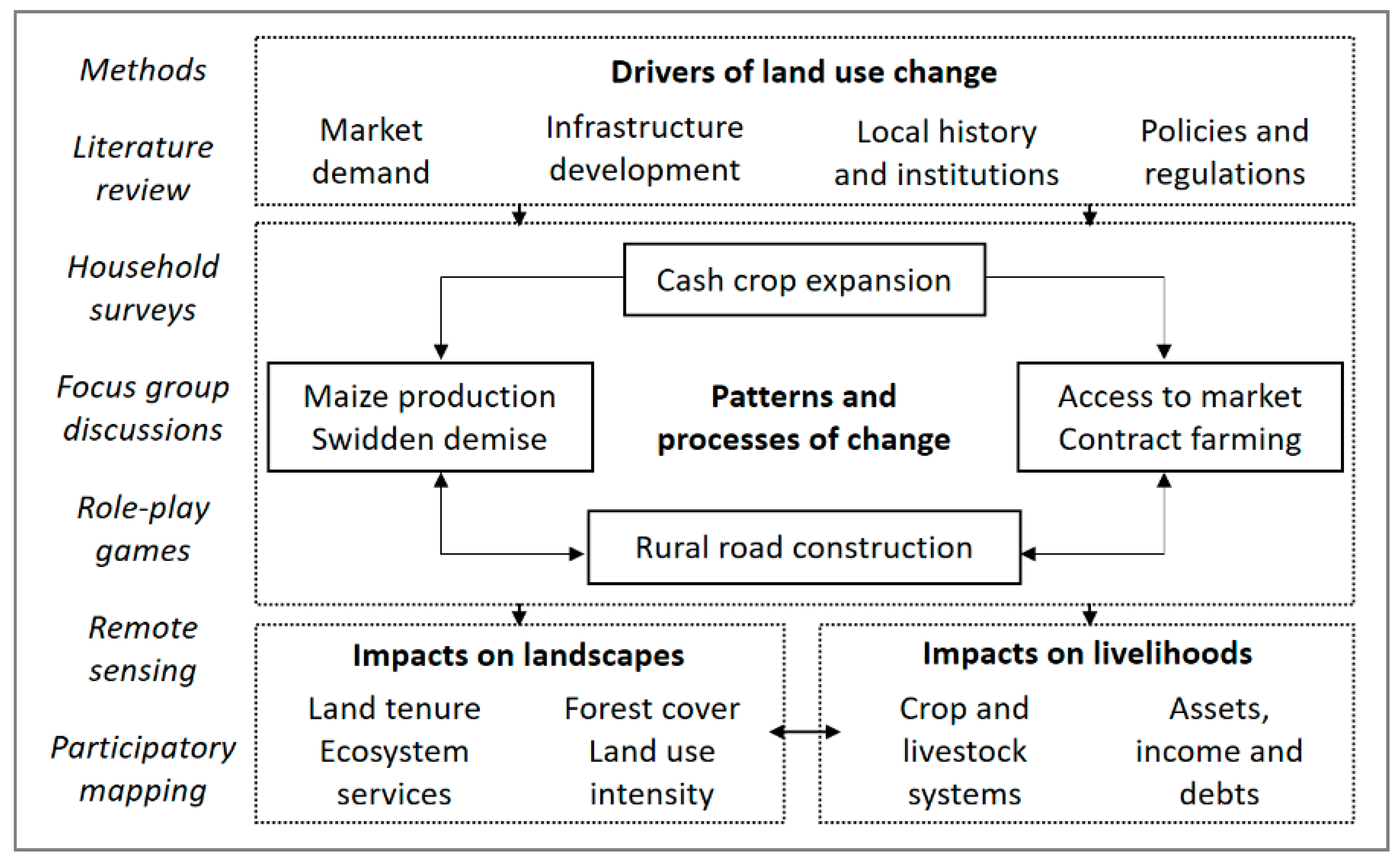


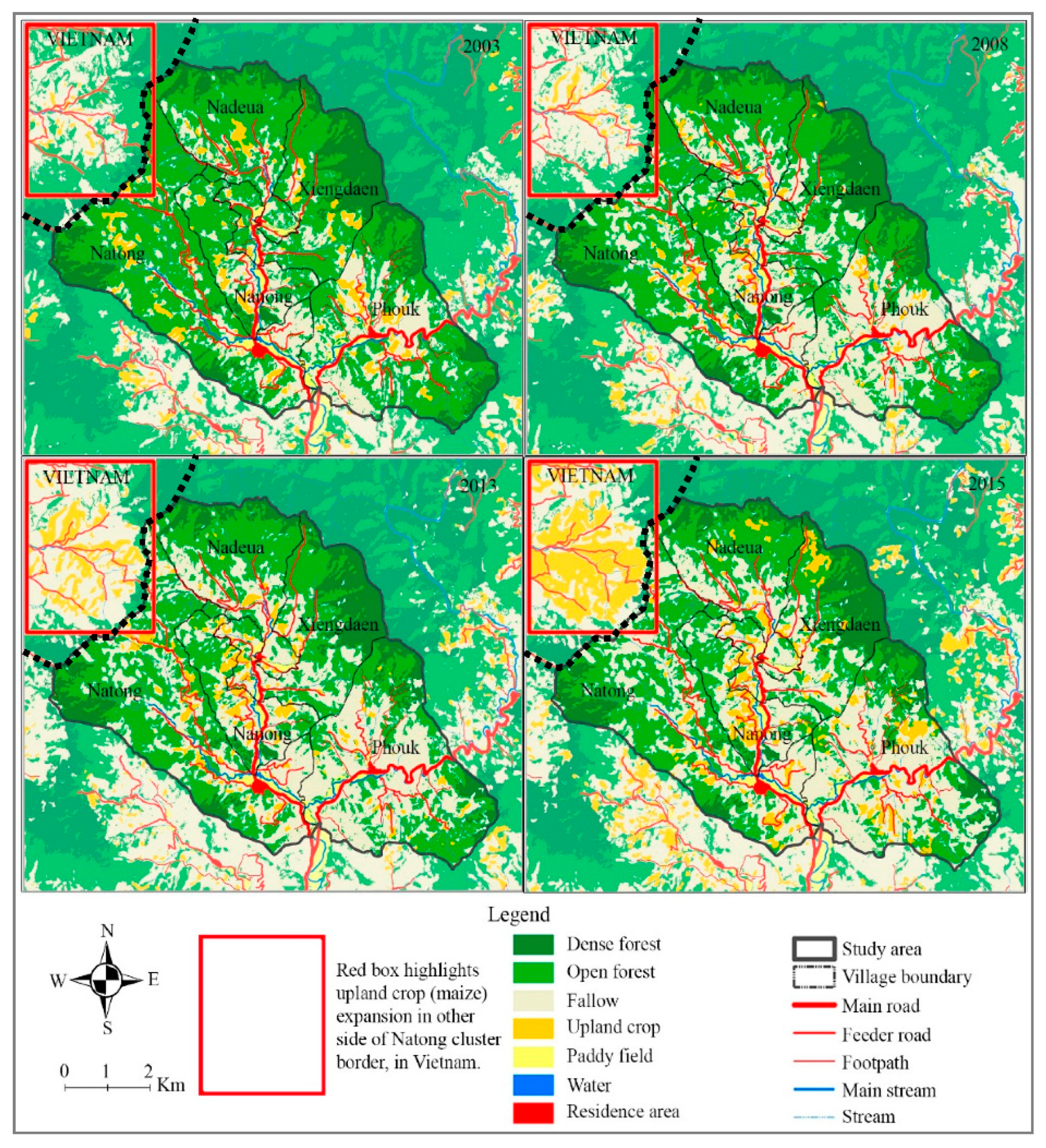
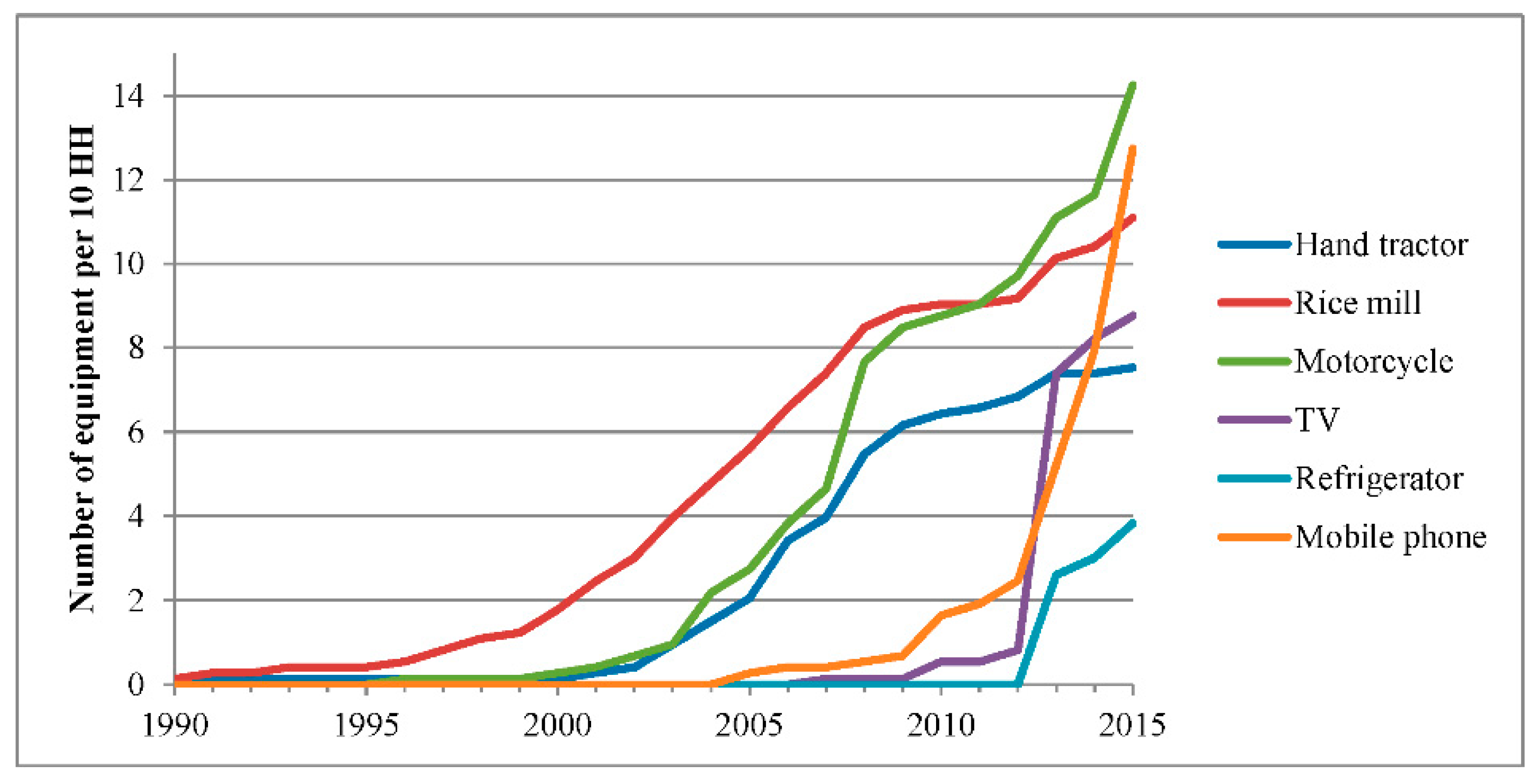
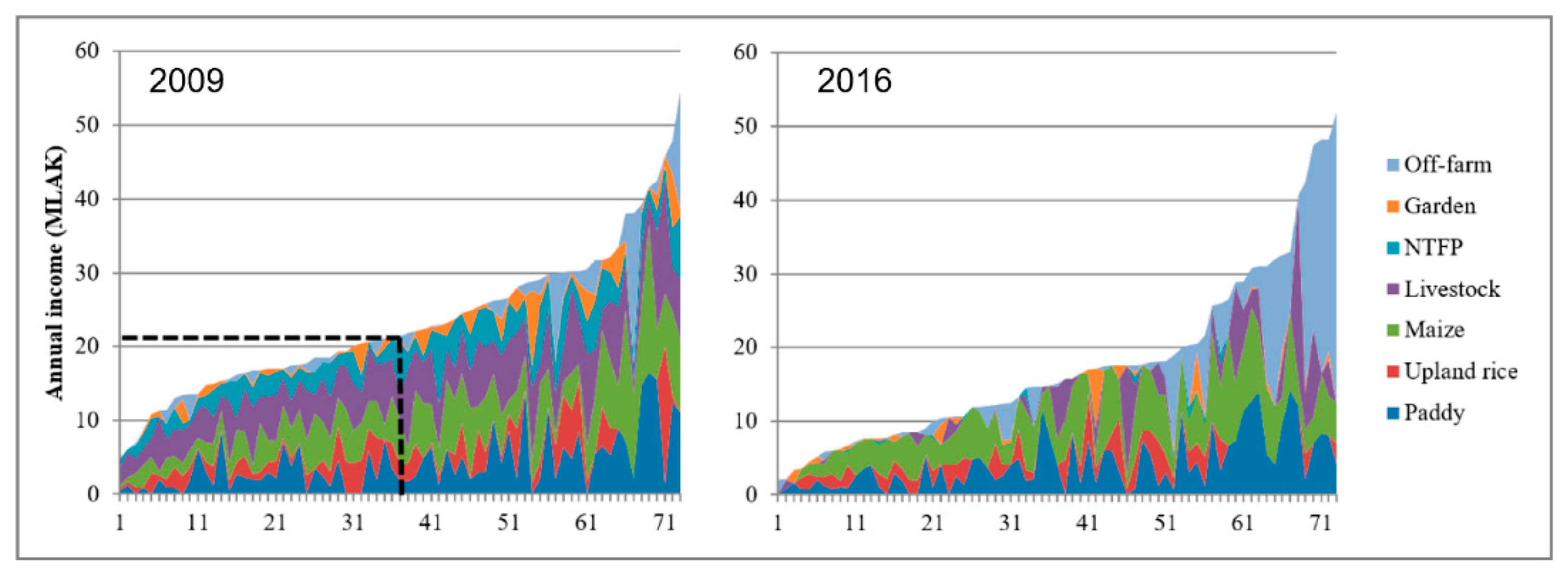
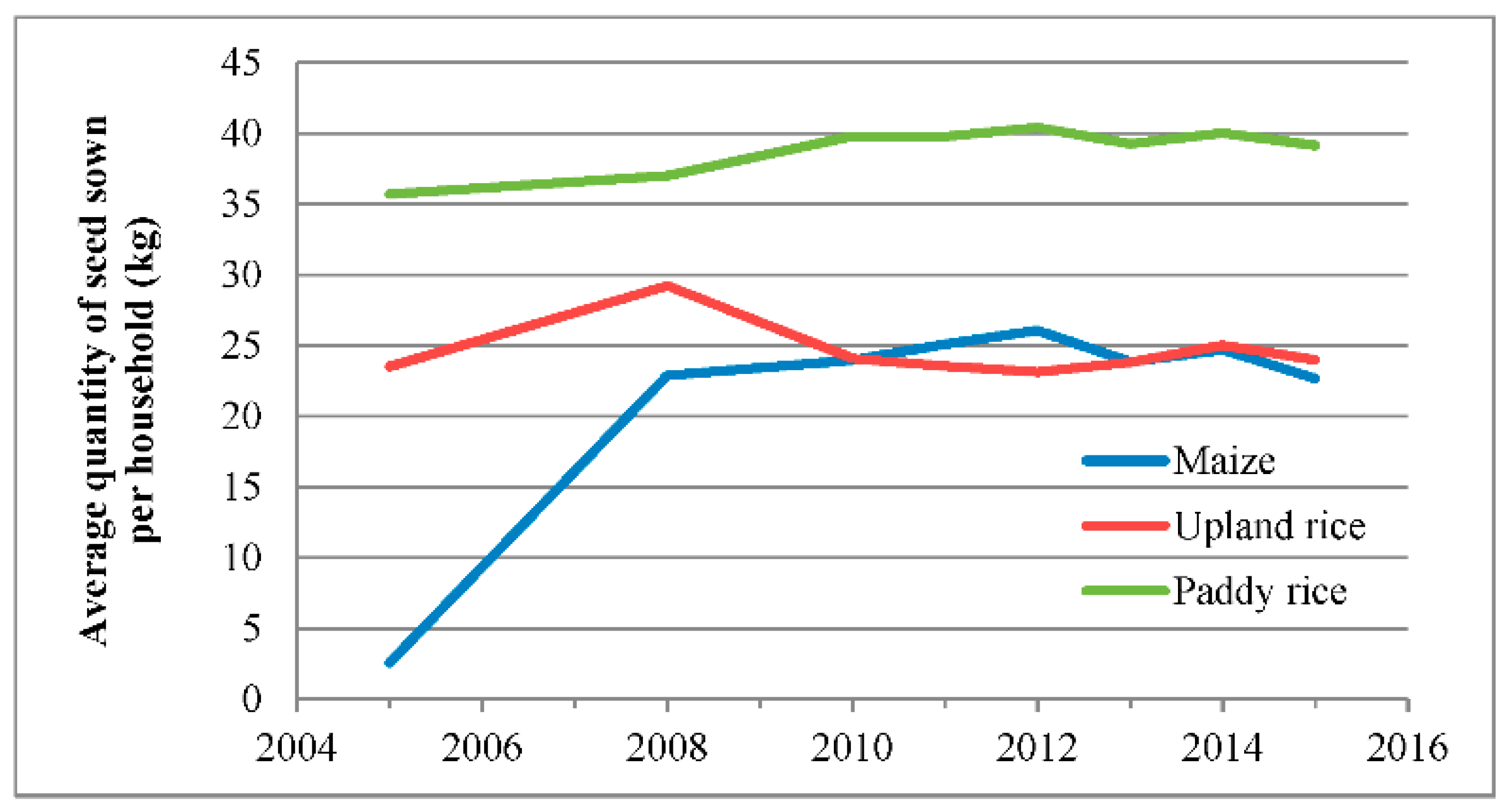


Publisher’s Note: MDPI stays neutral with regard to jurisdictional claims in published maps and institutional affiliations. |
© 2021 by the authors. Licensee MDPI, Basel, Switzerland. This article is an open access article distributed under the terms and conditions of the Creative Commons Attribution (CC BY) license (http://creativecommons.org/licenses/by/4.0/).
Share and Cite
Castella, J.-C.; Phaipasith, S. Rural Roads Are Paving the Way for Land-Use Intensification in the Uplands of Laos. Land 2021, 10, 330. https://doi.org/10.3390/land10030330
Castella J-C, Phaipasith S. Rural Roads Are Paving the Way for Land-Use Intensification in the Uplands of Laos. Land. 2021; 10(3):330. https://doi.org/10.3390/land10030330
Chicago/Turabian StyleCastella, Jean-Christophe, and Sonnasack Phaipasith. 2021. "Rural Roads Are Paving the Way for Land-Use Intensification in the Uplands of Laos" Land 10, no. 3: 330. https://doi.org/10.3390/land10030330







